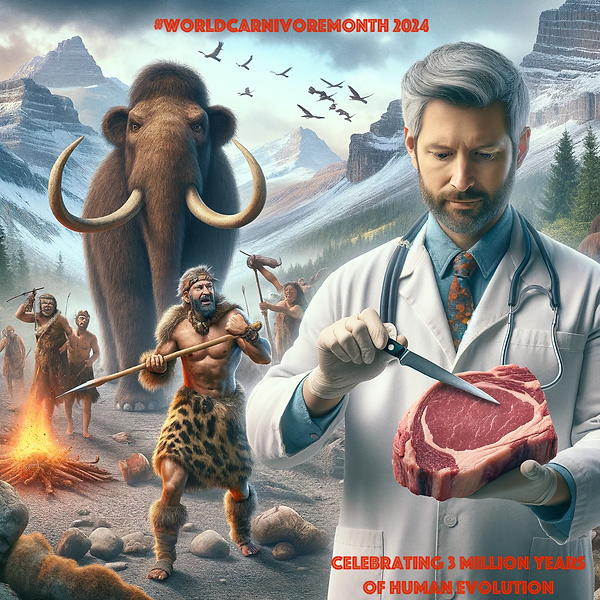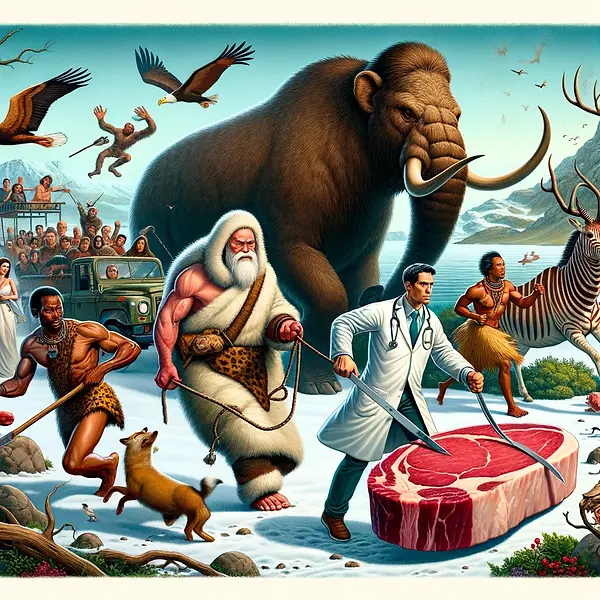


Title:
Ketosis prevents muscle wasting in high fat carnivores
Abstract:
Very-low-carbohydrate diets and preservation of muscle mass
Details
Very-low-carbohydrate diets and preservation of muscle mass
This commentary provides some basic information on metabolic adaptations that lead to sparing of muscle protein during a VLCARB, and reviews studies examining the effects of VLCARB interventions on body composition.
Metabolic adaptations in VLCARB
It is frequently claimed that a VLCARB sets the stage for a significant loss of muscle mass as the body recruits amino acids from muscle protein to maintain blood glucose via gluconeogenesis. It is true that animals share the metabolic deficiency of the total (or almost total) inability to convert fatty acids to glucose [18]. Thus, the primary source for a substrate for gluconeogenesis is amino acid, with some help from glycerol from fat tissue triglycerides. However, when the rate of mobilization of fatty acids from fat tissue is accelerated, as, for example, during a VLCARB, the liver produces ketone bodies. The liver cannot utilize ketone bodies and thus, they flow from the liver to extra-hepatic tissues (e.g., brain, muscle) for use as a fuel. Simply stated, ketone body metabolism by the brain displaces glucose utilization and thus spares muscle mass. In other words, the brain derives energy from storage fat during a VLCARB.
Glycolytic cells and tissues (e.g., erythrocytes, renal medulla) will still need some glucose, because they do not have aerobic oxidative capacity and thus cannot use ketone bodies. However, glycolysis in these tissues leads to the release of lactate that is returned to the liver and then reconverted into glucose (the Cori cycle). Energy for this process comes from the increased oxidation of fatty acids in the liver. Thus, glycolytic tissues indirectly also run on energy derived from the fat stores.
The hormonal changes associated with a VLCARB include a reduction in the circulating levels of insulin along with increased levels of glucagon. Insulin has many actions, the most well-known of which is stimulation of glucose and amino acid uptake from the blood to various tissues. This is coupled with stimulation of anabolic processes such as protein, glycogen and fat synthesis. Glucagon has opposing effects, causing the release of glucose from glycogen and stimulation of gluconeogenesis and fat mobilization. Thus, the net stimulus would seem to be for increasing muscle protein breakdown. However, a number of studies indicate that a VLCARB results in body composition changes that favour loss of fat mass and preservation in muscle mass.
How is the preservation of muscle mass brought about during a VLCARB?
There are at least four possible mechanisms:
Adrenergic stimulation
The increase in adrenaline may be involved. Low blood sugar is a potent stimulus to adrenaline secretion and it is now clear that skeletal muscle protein mass is also regulated by adrenergic influences. For example, Kadowaki et al. demonstrated that adrenaline directly inhibits proteolysis of skeletal muscle [6].
Ketone bodies
As noted above, the liver produces ketone bodies during a VLCARB and they flow from the liver to extra-hepatic tissues (e.g., brain, muscle) for use as a fuel. In addition, ketone bodies exert a restraining influence on muscle protein breakdown. If the muscle is plentifully supplied with other substrates for oxidation (such as fatty acids and ketone bodies, in this case), then the oxidation of muscle protein-derived amino acids is suppressed. Nair et al. reported that beta-hydroxybutyrate (beta-OHB, a major ketone body) decreases leucine oxidation and promotes protein synthesis in humans [7]. Although blood concentrations of beta-OHB in their subjects during the infusion of beta-OHB were much lower than concentrations observed in humans during fasting, leucine incorporation into skeletal muscle showed a significant increase (5 to 17%).
Growth hormone (GH)
GH has a major role in regulating growth and development. GH is a protein anabolic hormone and it stimulates muscle protein synthesis. As low blood sugar increases GH secretions, one could speculate that a VLCARB increases GH levels. However, Harber et al. reported that GH secretion was unchanged with 7-day VLCARB/high-protein diet [8]. Interestingly, they also observed that skeletal muscle expression of IGF-I mRNA increased about 2-fold. A plausible explanation for the increased expression of IGF-I in muscle is the increased availability of dietary protein.
Dietary protein
A VLCARB is almost always relatively high in protein. There is evidence that high protein intake increases protein synthesis by increasing systemic amino acid availability [21], which is a potent stimulus of muscle protein synthesis [22]. During weight loss, higher protein intake reduces loss of muscle mass and increases loss of body fat [9]. It has been proposed that the branched-chain amino acid leucine interacts with the insulin signaling pathway to stimulate downstream control of protein synthesis, resulting in maintenance of muscle mass during periods of restricted energy intake [10]. A recent study by Harber et al. reported that a VLCARB/high-protein diet increases skeletal muscle protein synthesis despite a dramatic reduction in insulin levels [8].
Conclusion
Although more long-term studies are needed before a firm conclusion can be drawn, it appears, from most literature studied, that a VLCARB is, if anything, protective against muscle protein catabolism during energy restriction, provided that it contains adequate amounts of protein.
How Ketones Spare Protein in Starvation
Abstract
An infusion of β-hydroxybutyrate decreased amino acid oxidation and increased protein synthesis in humans.
Hypothesis:
We expect high fat megafauna hunters to preserve their muscles by eating enough protein and being in constant ketosis.




